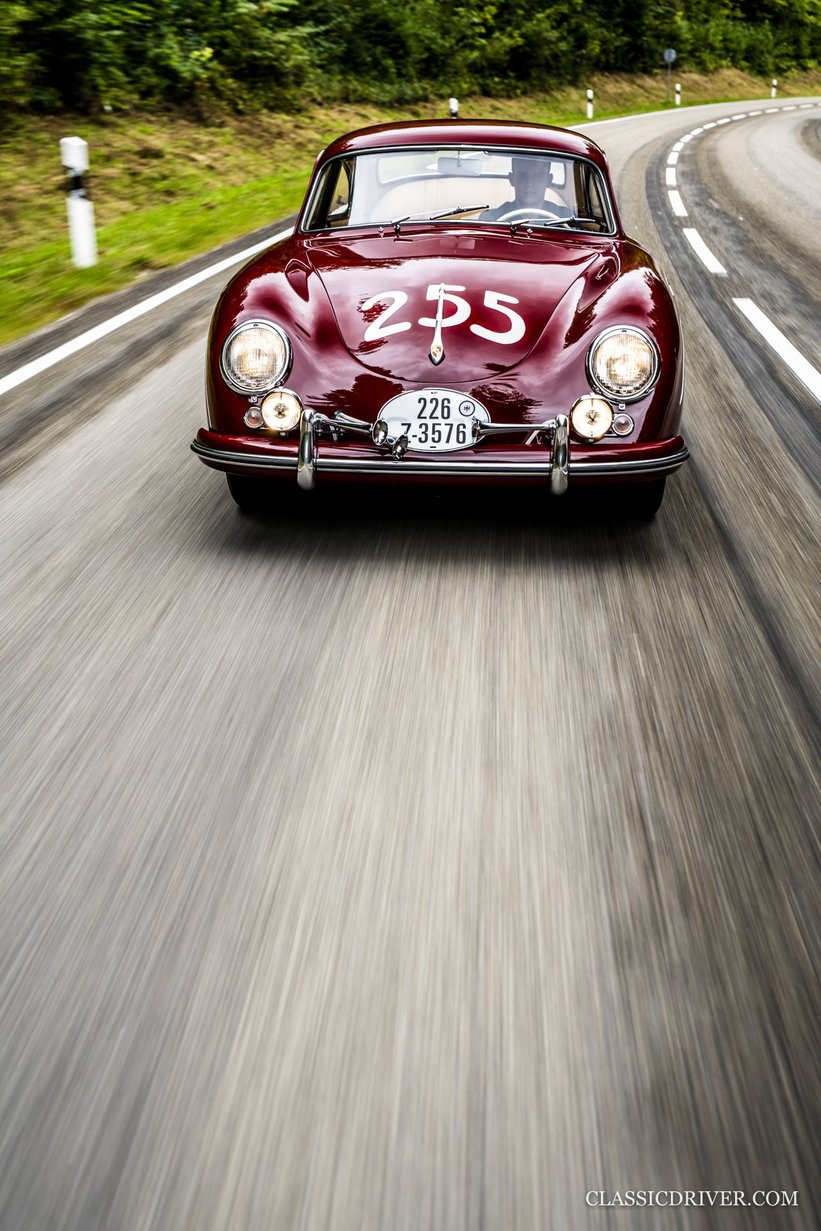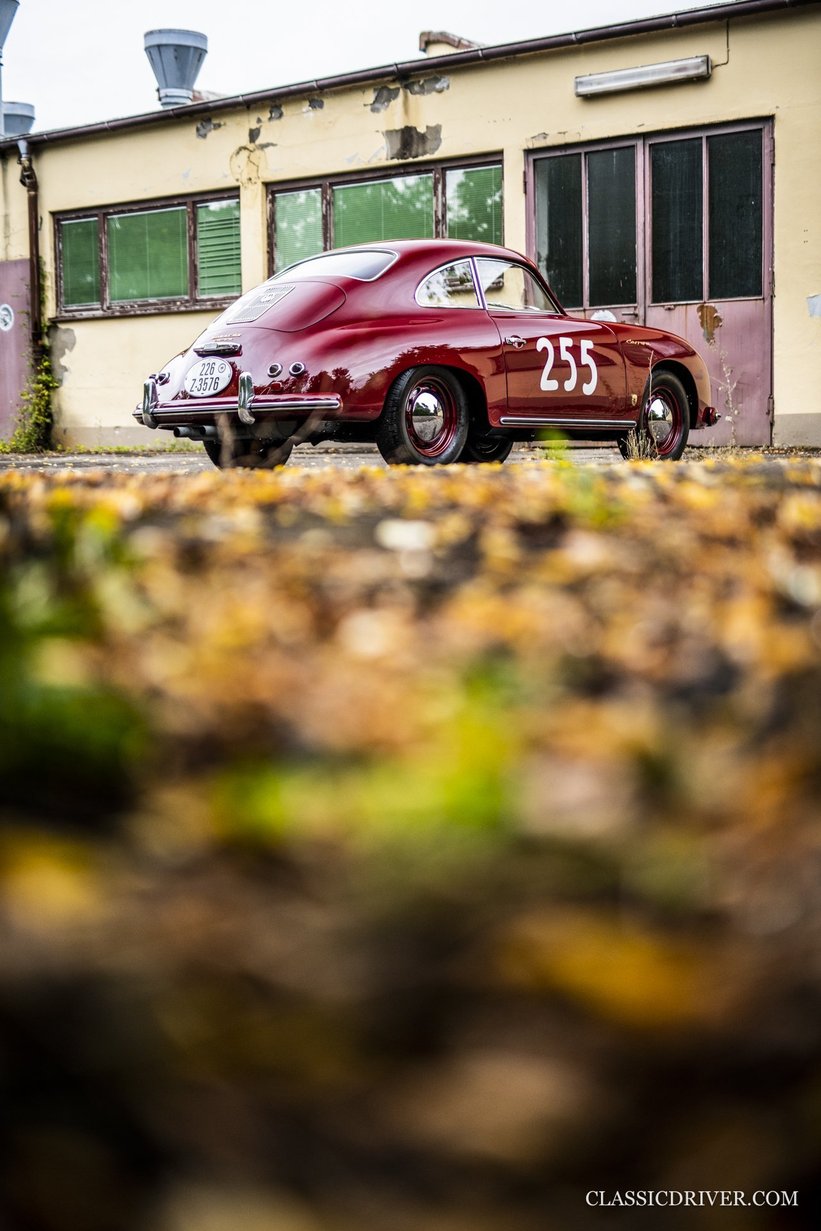


Olof "Grus Olle" Persson (1911-1971) was one of Sweden's most successful private racing drivers in the 1950s. As early as 1952, he won the Rally to the Midnight Sun (Midnattssolsrallyt), which was held for the first time in 1950, in a Porsche 356 1500 Super. The three following years, too, saw this forerunner of the later Rally Sweden won by drivers of the Zuffenhausen sports car. Persson's greatest success, however, was the victory in the GT class up to 1.6 litres in a Porsche 356 at the Mille Miglia in 1956. The Scandinavian picked up the brand-new 356 A Carrera with chassis number 56063 himself in Stuttgart, with a customs license plate, and drove it directly from there to the start of the Mille in Brescia. Ferry Porsche, who was well known to have a heart for privateers, granted him a 10% ‘racing-driver discount’.


Persson started early, at 2:55am, as evidenced by the starting number that was hand-brushed with white paint for all participants on-site. You have to know that at the Mille, the favourites for the overall victory were always released at the very end. In 1956, for example, it was Juan Manuel Fangio in a Ferrari 290 MM, which – as the final one – rolled off the ramp at exactly six o'clock. The race actually started with tiny Fiats, Renaults, Panhards and others many hours earlier, which then had to be laboriously overtaken by the big shots. While the factory Porsches – including the 550 RS Spyder driven by Hans Herrmann and navigator Werner Enz with a start time of 4:19am, or the Porsche driven solely by Giovanni Bracco (start time 4:29am) – both retired, two Porsche 356s saved the honour of Stuttgart. Persson and co-driver Gunnar Blomqvist came in 18th in the overall classification in Brescia and after 13:32.64 driving time clinched the 1.6-litre GT category with a margin of seven minutes and 43 seconds over their brand colleagues Max Nathan (Germany) and Gert Kaiser (Sweden).



The 1956 Mille went down in the annuals as one of the most chaotic editions of the infamous event. In that year, the writing was already on the wall. The madness of thundering through half of Italy on public roads at insane speeds with no real spectator protection was ever-more frightening, to say the least. To make matters worse, during the 1956 edition it also poured with rain. As a result, there were several fatal accidents and almost half the starters had to retire their cars with technical defects, including Hermann in the factory Spyder, who had to park shortly before Rome with defective ignition.



For Persson, who was no longer the youngest at the age of 45, it was the first Mille Miglia. As a successful building contractor, he also drove cars of other brands, such as a Mercedes 300 SL and various Ferraris. In his Bordeaux Red-painted Porsche with two large compressor horns on the front bumper, he competed again in the then-last edition of the Mille Miglia, this time with starting number 227 and the Swedish registration plate AA-3833. But in 1957, he didn't reach the finish line, even though Porsche celebrated a triple class win, with the top pairing Paul-Ernst Strähle and Herbert Linge at the top.


For the 1000km race on the Nürburgring 14 days later, Persson lent his car to Herbert Linge and Hans Walter, who finished 26th in the overall classification and third in the GT 1.6-litre class behind two other 356s. Persson himself last entered his 356 in February and March 1958 at four national events, which he finished with three wins and a third place. On 28 August 1958, he sold the Porsche, and ended his active racing career in 1959.



After the 356 initially passed through several Swedish hands, it disappeared from the scene in 1970. It was stored in individual parts, together with two Carrera engines, in a Swedish hall. It fell into oblivion: even the otherwise well-informed Porsche archive couldn’t provide information about the car.



Early in 2018, the Mille Miglia class winner, believed to be lost, hit Boxer Motor in the Swabian town of Balingen. With its original engine, gearbox and axles. The new Swedish owners – actually the two sons of former Persson competitor Gert Kaiser – wanted the car to be converted back to the state of the Mille Miglia in 1956. The Swabian workshop was the right address for them, since word of their supreme Porsche know-how had long since spread to Scandinavia. And so with a lot of verve and passion, the Boxer Motor crew set to work under the direction of company boss Christoph Schlagenhauf. Fortunately, they had access to extensive photography of the Mille Miglia from 1956 with many original images; there was even some of the original paint left in the glove compartment. “That was a lucky convenience, since the car upon delivery was covered on the outside with a rust protection primer,” explains Schlagenhauf. But until the final colour selection was determined, several paint samples first went to Sweden.


At the time, Persson had chosen a rather simple finish for the interior: beige synthetic leather, known at Porsche as ‘Bast’. Schlagenhauf succeeded in getting to remnants of this synthetic leather through contacts with the Reuter company, which in addition to bodyshells for Porsche, also used to manufacture interior materials for the 356.



The two 1.5-litre Carrera engines included in the package have also been completely overhauled. “Both the matching-numbers engine and a spare motor were removed, but complete and not in pieces,” says Schlagenhauf. Only for this job, Boxer Motor commissioned an external partner, who conveniently operates in Schorndorf, around 60 miles away: Karl Hloch, which, in addition to great 911 expertise, is also known as THE upright shaft specialist. Even if the roller-bearing crankshaft of the ‘Fuhrmann’ engine is known to not be ideal for everyday use (the oil pressure required to reliably lubricate the roller bearings is only built up at higher speeds) they were reinstalled for the sake of originality.


On the basis of the contemporary images, the ex-Persson car again received its two horns, the additional headlights and the oval customs license plate. Even the winner's badge, which the Swede received from the organisers for winning the Mille, is now emblazoned on the rear ventilation grille.



So the 356, which saved Porsche's 1956 honour at the Mille Miglia, is back in top form today, with all matching numbers and historically correct exterior colour and interior trim materials. “Certainly one of the most historically significant cars that we’ve ever restored”, emphasises Schlagenhauf. At the time of writing, the 356 is on its way back to Sweden, together with a second, blue 356, which was a winner of the Midsummernight Rally.



When the historic racing and concours season hopefully returns to a more normal situation during 2021, the Kaisers intend to enter Chassis 56063 – in the footsteps of Olof Persson – at the ‘modern’ Mille Miglia, as well as putting it on display at concours like the Villa d'Este. Full circle after 65 years!
Photos: Rémi Dargegen © 2020





















































